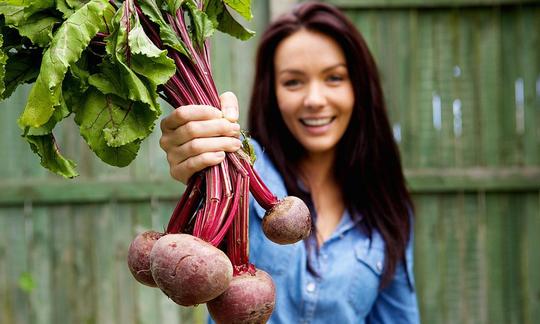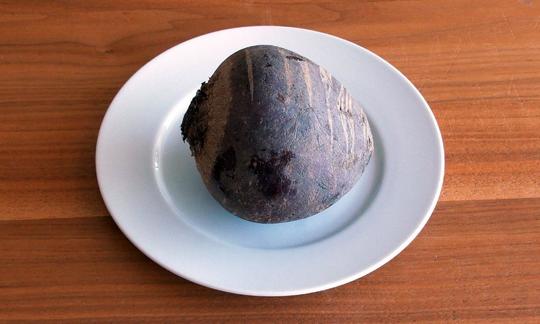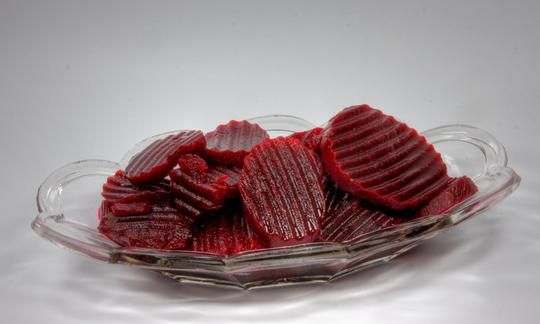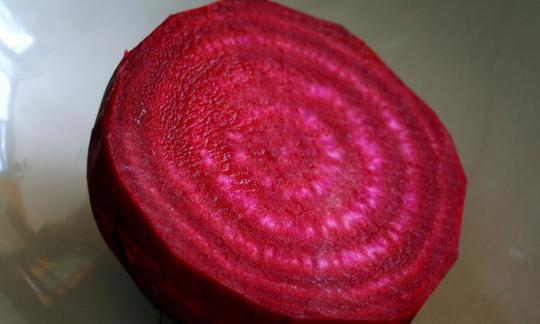Table of contents
Beetroot ( Beta vulgaris subsp. vulgaris Conditiva Group), also known as red beet and in Switzerland as beetroot, has a distinctive red colour and a characteristic earthy flavour and can be eaten raw or cooked - preferably in organic quality. Beetroot is a popular ingredient in many traditional dishes and has health benefits.
Use in the kitchen
The earthy taste of beetroot is not for everyone, but the sweet beet combines incredibly well with everything, but especially with sour or highly umami-rich foods. The taste intensifies as the tuber ages. The leaves are also edible and, like fresh spinach, can be steamed briefly for processing. Since they wilt quickly, they are a good indicator of the freshness of the tuber.
Can you eat beetroot raw? You can eat beetroot raw. Young beetroot (baby beets) in particular can be served raw and thinly sliced as carpaccio or finely grated and mixed into a salad. It also tastes good raw in a smoothie or as a direct juice. As a starter, it can be prepared as a vegan tartare, in a dip with vegetable sticks or as a raw beetroot soup. Raw beetroot can also be fermented if finely sliced.
Peeled and cooked beetroot can be used in a variety of salads: with a dressing made from mustard and balsamic vinegar, it tastes great with lamb's lettuce and oranges. Beetroot is known for a heartier dish when finely grated, doused with hot apple cider vinegar and seasoned with caraway seeds and horseradish. A soup made from cooked beetroot, refined with soy sauce and oat cream, has a much sweeter note than the raw version. To give dishes a nice color, beetroot can also be mixed into falafel, gratins, casseroles or quiches. Or you can use it to color vegan omelettes, risotto or create a beetroot hummus.
Ingredients that go well with the red winter vegetables include walnuts, pine nuts, chickpeas, lentils and spices such as rosemary and mint.
Due to its natural sweetness, beetroot is also an excellent ingredient for desserts. Cooked beetroot gives cakes, especially chocolate cakes, a juicy consistency. Vegan creations such as panna cotta, porridge, sorbets and fruit desserts can certainly be made with beetroot.
Beetroot is a delicious and nutritious addition to a variety of dishes. To preserve the valuable ingredients, it is recommended to boil or steam the beet with the skin on. The cooking time varies depending on the ripeness and size of the beet (20-45 minutes). This effort is worth it, as the earthy taste and incomparable aroma make every dish something special. To prevent the red color from sticking too much to your fingers, you can wear gloves when handling it.
Recipe for a raw vegan beetroot soup
Ingredients for 4 people: 450 g tomatoes, 1 beetroot (raw, organic), ½ green bell pepper, ½ onion, 1 avocado, 1 clove of garlic, 6 fresh basil leaves, salt,pepper.
Preparation: Place all the ingredients, slightly chopped (peeled), in a high-performance blender and puree finely. Depending on the consistency, you can add a little water and season with salt and pepper to taste. Decorate the vegan and raw beetroot soup in the plate with basil leaves.
Vegan recipe for beetroot and bean salad with apples
Ingredients for 4 people: 3 beetroots (cooked, organic), 2 apples, 200 g cooked white beans, 2 tbsp rapeseed oil, 2 tbsp white wine vinegar, salt, pepper.
Preparation: Remove the core of the washed apples. Cut into small pieces and place in a bowl with the cooked beans. Mix the white wine vinegar and rapeseed oil and pour over the bean-apple mixture. Mix everything well and season with salt and pepper. Finally, cut the cooked and then peeled beetroot into small pieces, pour over the bean-apple mixture and fold in carefully.
Vegan recipes with beetroot (raw) can be found under the note: " Recipes that have the most of this ingredient ".
| Not only vegans or vegetarians should read this: Vegans often eat unhealthily. Avoidable nutritional errors. |
Purchasing - Storage
Depending on the country, beetroot is also available in stores under the name red beets (AT) or beetroot (CH). Beetroot is generally available all year round. The harvest time is from the beginning of August to the end of November and this is when the winter vegetable is particularly fresh. Beetroot can be found both raw and cooked, vacuum-packed in bags or preserved in jars, in all well-stocked supermarkets such as Coop, Migros, Denner, Volg, Spar, Billa, Aldi, Lidl, Rewe, Edeka and Hofer, often in organic quality. Organic supermarkets such as Alnatura or Denn's Biomarkt also sell organic beetroot raw and preserved. In season, fresh beetroot is also available at weekly markets.
The availability of beetroot in the supermarkets mentioned depends on the size of the store, the catchment area, etc. If you are interested, click on our recorded food prices for the DA-CH countries (above under the ingredient image). There you will find current prices from various supermarkets and their price development.
Storage tips
If you don't process the beetroot or preserve it straight away, you can store it. Wrapped in a damp cloth in the vegetable compartment of the fridge, raw beetroot will stay fresh for two to three weeks. For longer-term storage, place the beetroot in a box with damp sand. It is best to store it in a dark, cool cellar (max. 5 °C) with high humidity. Cooked beetroot should be used within a few days or frozen in portions.
Found in the wild
The red beet ( Beta vulgaris ssp. vulgaris Conditiva Group) 1 is probably descended from the wild beet ( Beta vulgaris ssp. maritima), which can still be found in the wild in coastal areas of the Mediterranean, Western Europe, Northwest Africa and India. They also grow in California and Australia. Northern areas as far south as Scotland are also known. 2
Ingredients - Nutritional values - Calories
The energy content of a raw beetroot is rather low at 43 kcal per 100 g. With 1.6 g of protein per 100 g, the beetroot is low in protein. Since the fat content is 0.17 g/100g, it also contains hardly any omega-3 fatty acids (alpha-linolenic acid). The carbohydrate content of the beetroot is 9.6 g/100g. 3
Raw beetroot contains 109 µg/100g of folate, which is about 55% of the daily requirement. Sprouted lentils (100 µg/100g) and walnuts (98 µg/100g) have similar levels of the vitamin. Pulses contain a lot of folate. It is important to know that the cooking process reduces the folate content: raw chickpeas have 557 µg/100g and cooked chickpeas only contain 63 µg/100g. 3
Raw beetroot contains 325 mg of potassium, which is about 16% of the daily requirement.Broccoli and porcini mushrooms contain just as much potassium. Seaweed (eg kombu seaweed : 6,100 mg/100g) has a high potassium content. 3
You often read or hear that beetroot contains a lot of iron. But at 0.8 mg/100g, the iron content is similarly low to that of oranges. Oatmeal has significantly more iron at 4.4 mg/100g. 3
The complete ingredients of beetroot (raw), the coverage of the daily requirement and comparison values with other ingredients can be found in our nutrient tables. In the article Nutrients explained you will get a detailed insight into the topic.
Health effects
Is beetroot healthy? Although nitrate and nitrite can have negative effects, as mentioned above, there are studies that also show a positive effect. For example, dietary nitrate can lower blood pressure in healthy people because it causes blood vessels to dilate. 7,8 Beetroot juice also increases the level of nitric oxide (NO), which has numerous functions in the context of increasing blood flow, gas exchange, mitochondrial biogenesis and efficiency, and strengthening muscle contraction. Supplementation with beetroot juice could therefore have effects on cardiorespiratory endurance, which has a positive effect on athletic performance. 12
The flavonoids, polyphenols and other secondary plant substances contained in beetroot are said to reduce unwanted side effects in cancer patients during chemotherapy and improve human performance. More detailed studies are still needed to provide more concrete information. 9
Natural colorants such as betalains have anti-inflammatory, antioxidant, immunomodulatory and cancer-preventive effects. These health-promoting effects of betalains have attracted the interest of the food and medical industry in using them as a functional food ingredient. 10 In addition, beetroot is said to eliminate the unpleasant smell of garlic. 8
Beetroot extracts can positively influence the composition and activity of the intestinal microbiome, exerting a noticeable bifidogenic effect and stimulating the growth and metabolism of probiotics. 13
Dangers - Intolerances - Side effects
Is beetroot unhealthy? Like spinach and chard, beetroot can store a lot of nitrate. The body converts some of the nitrate into nitrite. High doses of nitrite can be dangerous, especially for infants, which is why maximum levels have been set for plant-based foods. Depending on the growing area and fertilization, the nitrate content in vegetables can vary greatly. However, normal amounts do not pose a health risk. 4 Nitrate and nitrite, which get into our food via preservatives, are significantly more dangerous. 5
Because beetroot contains oxalic acid, people with kidney problems or kidney stones (salts that form crystals) should be careful when eating foods that contain oxalic acid. 6,14 Normal consumption amounts do not pose a significant risk. In addition, the chronic accumulation of oxalic acid in the body can be prevented by taking calcium. Calcium neutralizes oxalic acid. Therefore, combine your beetroot dish with a calcium-containing food. Cooking the tubers and leaves reduces the oxalic acid content. In addition, drinking plenty of fluids helps the body flush out oxalic acid. 16
Ecological footprint - animal welfare
Regional, fresh beetroot has a low ecological CO 2 footprint of 0.2 kg CO 2 e/kg of food. In glass, this increases to 1.3 kg CO 2 e/kg thanks to additional production steps. 11 Ideally, you should buy beetroot raw and unpackaged, which saves you having to use plastic or glass packaging. The amount of water needed to produce 1 kg of beetroot is 385 litres. 17
Regional vegetables are also preferable. Beetroot is native to the DA-CH countries and can be bought from regional growers almost all year round because it is easy to store. This eliminates the long transport routes and excessive water consumption that is required for non-seasonal vegetables from dry areas.
Conventional agriculture uses large amounts of synthetic fertilizers and pesticides, which can also be found in the end product. This also applies to beetroot - so you should look for products from organic farming when buying. 18
Worldwide occurrence - cultivation
Beetroot is a cultivated form of the common beet ( Beta vulgaris ssp. vulgaris), similar to sugar beet and chard. The common beet in turn is descended from the wild beet, which probably originated in the Mediterranean region. 2
Cultivation - Harvest
Beetroot is an easy vegetable to grow. The plants can adapt to almost any soil. They grow well not only in the garden, but also in a tall flowerpot on the balcony or terrace. Beetroot prefers a sunny to partially shaded location. The soil should always be slightly moist. Be careful when fertilizing. The plant needs a lot of potassium, but does not tolerate too much nitrogen. Therefore, use a natural fertilizer that is high in potassium and low in nitrogen. 15
The seeds should be started in April. They should be planted outdoors from May - ideally at a distance of 5 to 7 cm and a depth of 2 to 3 cm. As soon as the plants are about 10 cm tall, they should be pricked out and the strongest ones left standing. Varieties with smaller tubers are ready for harvest after 8-12 weeks, larger varieties after 10-13 weeks. Beetroot should be harvested before the first frost. 15
Further information
Beetroot belongs to the family Amaranthaceae and to the subfamily Betoideae, which includes the tribe Beteae (beets).
Beetroots are predominantly red, but there are also varieties with yellow or red-white bulbs. 14
Alternative names
Besides red beet and beetroot (beetroot), regional names such as Rahnen (AT), Randen (Switzerland), Rannen (Bavaria), but also Rauna, Rana, Rohne, Rone, Ronen, Randig, Randich, Rohna are known.
The English name for beetroot is beetroot.
Other uses
Beetroot used to be used as a dye plant. The dye betanin (beetroot red) is still used today as a natural food coloring (E162). 15
Bibliography - 18 Sources
| 1. | Plantnames.unimelb.edu.au Beta vulgaris L. subsp. vulgaris (Conditiva Group). |
| 2. | Driessen S. Beta vulgaris subsp. maritima an Deutschlands Ostseeküste. Dissertation. Aachen. 2003. |
| 3. | USDA. United States Department of Agriculture. |
| 4. | LGL. Bayerisches Landesamt für Gesundheit und Lebensmittelsicherheit. Nitrat in Roter Bete: Untersuchungsergebnisse. 2013. |
| 5. | AGES. Österreichische Agentur für Gesundheit und Ernährungssicherheit. Nitrat und Nitrit. |
| 6. | Han H, Segal AM, Seifter JL, Dwyer JT. Nutritional management of kidney stones (Nephrolithiasis). Clin Nutr Res. Juli 2015;4(3):137–52. |
| 7. | Ghosh SM, Kapil V, Fuentes-Calvo I, Bubb KJ, Pearl V, Milsom AB et al. Enhanced vasodilator activity of nitrite in hypertension: critical role for erythrocytic xanthine oxidoreductase and translational potential. Hypertension. 2013 May;61(5):1091-1102. |
| 8. | Amin AR, Kassab RB, et al. Comparison among garlic, berberine, resveratrol, Hibiscus sabdariffa, genus zizyphus, hesperidin, red beetroot, catha edulis, portulaca oleracea, and mulberry leaves in the treatment of hypertension and type 2 DM: a comprehensive review. Natural Product Communications, 15(4). 2020. |
| 9. | Tan ML, Hamid SBS. Beetroot as a Potential Functional Food for Cancer Chemoprevention, a Narrative Review. J Cancer Prev. 2021 Mar 30;26(1):1-17. doi: 10.15430/JCP.2021.26.1.1. |
| 10. | Fu Y, Shi J, Xie SY, Zhang TY, Soladoye OP, Aluko RE. Red beetroot betalains: perspectives on extraction, processing, and potential health benefits. J Agric Food Chem. 21. Oktober 2020;68(42):11595–611. |
| 11. | Reinhardt G, Gärtner S, Wagner T. Ökologische Fussabdrücke von Lebensmitteln und Gerichten in Deutschland. Ifeu Institut für Energie- und Umweltforschung Heidelberg. 2020. |
| 12. | Domínguez R, Cuenca E, Maté-Muñoz JL, García-Fernández P, Serra-Paya N, Estevan MCL, u. a. Effects of beetroot juice supplementation on cardiorespiratory endurance in athletes. A systematic review. Nutrients. 2017;9(1):43. |
| 13. | De Oliveira SPA, do Nascimento HMA, Sampaio KB, de Souza EL. A review on bioactive compounds of beet (Beta vulgaris L. subsp. vulgaris) with special emphasis on their beneficial effects on gut microbiota and gastrointestinal health. Crit Rev Food Sci Nutr. 2021;61(12):2022–33. |
| 14. | Pflanzen-lexikon.com Rote Bete - Rote Rübe (Beta vulgaris subsp. vulgaris var. conditiva). |
| 15. | Plantura.garden Rote Beete im Portrait: Die gesunde Rübe aus dem eigenen Garten. |
| 16. | Washcoll.edu Beets. |
| 17. | Mekonnen MM, Hoekstra AY. The green, blue and grey water footprint of crops and derived crop products. Hydrol. Earth Syst. Sci. 2011; 15: 1577-1600. |
| 18. | Pesticide Action Network Europe. Forbidden Fruit. 2022. |

















Comments